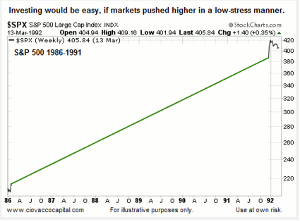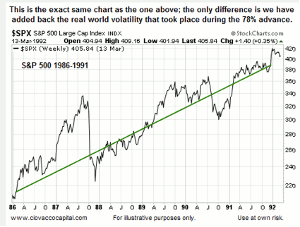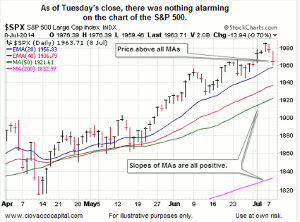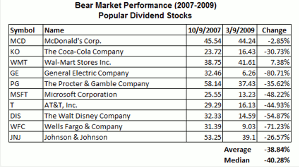Chris Ciovacco at WallStreetSectorSelector.com points out the recent weakness in major US stock indices and the implications of this.
Recent weakness in major US stock indexes has investors wondering if bull market is in trouble. After marching to new records, the bull market is showing new signs of fatigue. The Dow has given back 17,000 (DIA) and a bout of selling has hit the S&P 500 (SPY), Nasdaq (QQQ), and Russell 2000 (IWM) indexes.
After weakness on Monday and Tuesday, stock market bulls were trying to regain the upper hand Wednesday after the latest Federal Reserve minutes were released.
Volatility To Respect?
After rallying 170 points between April 11 and July 3, the S&P 500 gave back 21 points on Monday and Tuesday. The longer you study markets and investor psychology, the more apparent it becomes that your investment approach should balance these two basic objectives:
1. We need to leave our investments alone long enough to make money. All things being equal, we prefer to trade less, rather than more, frequently.
2. When prudent, we need to adjust our portfolios to avoid the next inevitable bear market or financial crisis.
Without Volatility Investing Would Be Easy
If volatility was not part of the equation, we could all “stay the course” while capturing the S&P 500’s 78% advance that occurred between early 1986 and late 1991 (see graph below). Unfortunately, markets are not that easy.
Capturing even a portion of the 78% gain was much more difficult in the real world, which is marked by regular ups and downs during any market advance.
How About Recent Volatility?
From a probability perspective, there are numerous ways to help discern between “volatility to ignore” and “volatility to respect.” One method is to use moving averages as a guide. How did the moving averages (MAs) look as of the close on Tuesday, July 8?
As shown in the chart below, the market was still in “volatility to ignore” mode.
It Is New to You if You Have Not Seen It
Since the topic of dividend investing falls outside of our writing norms, you may have missed yesterday’s analysis of the performance of blue-chip dividend payers during the last bear market. The table below provides some insight.
Investment Implications—No Changes
Based on the evidence and our disciplined rules, we made no allocation changes during Monday and Tuesday’s pullback in stocks. We continue to hold US stocks (SPY) and leading sectors, such as technology (QQQ). Since there are always things to be concerned about (valuations, earnings, Fed taper, Europe, Iraq, etc.), we will continue to monitor the hard evidence with a flexible and open mind. Thus far, the reaction to earnings season has been favorable, or at least not bull market derailing.
By Chris Ciovacco at WallStreetSectorSelector.com

























